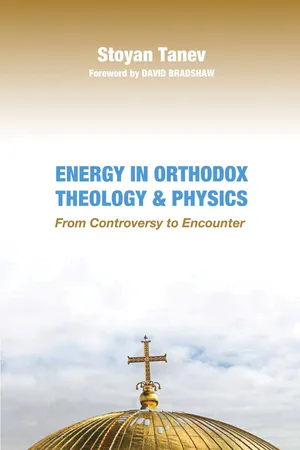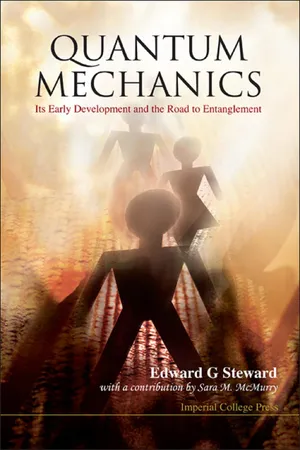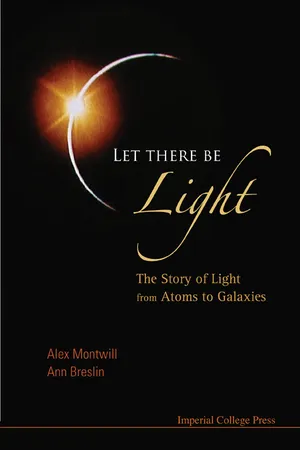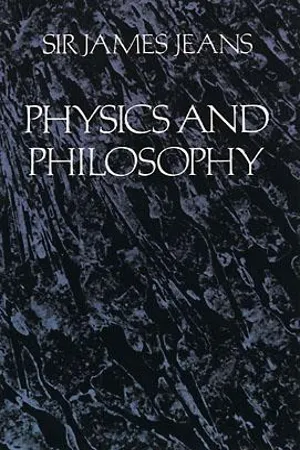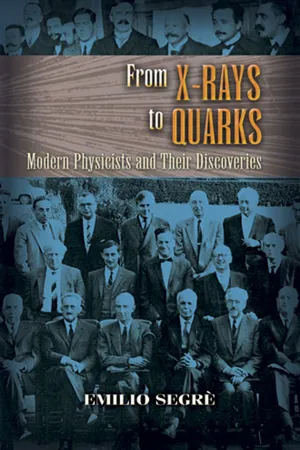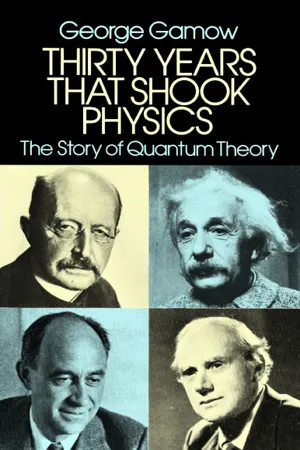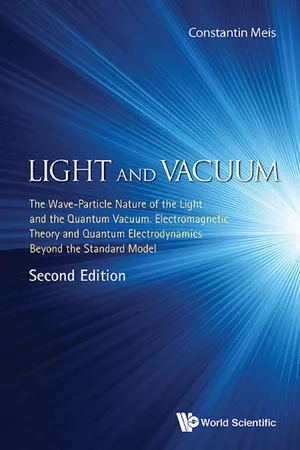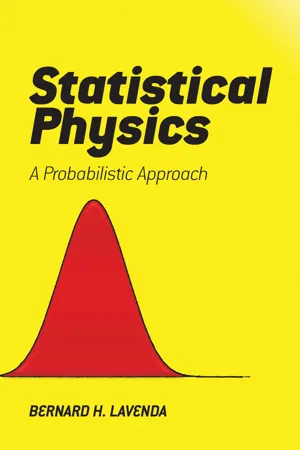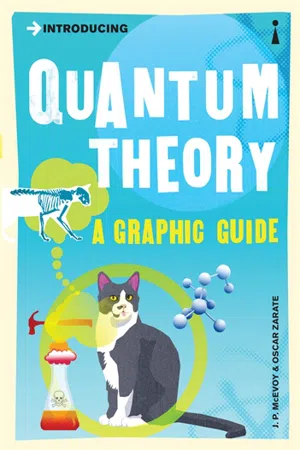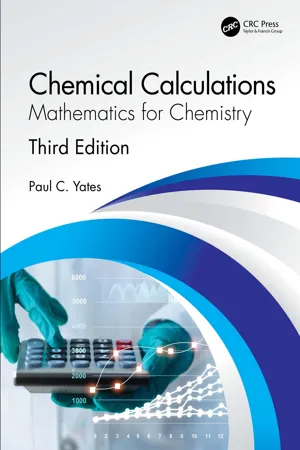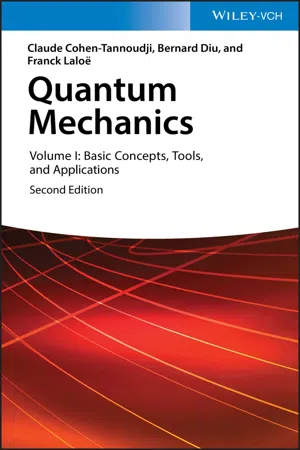Physics
Plancks Quantum Theory
Planck's quantum theory revolutionized physics by proposing that energy is emitted or absorbed in discrete units called quanta. This theory laid the foundation for quantum mechanics and challenged classical physics, leading to the development of modern physics. Planck's work was instrumental in explaining phenomena such as blackbody radiation and the photoelectric effect, and it ultimately transformed our understanding of the behavior of matter and energy at the atomic and subatomic levels.
Written by Perlego with AI-assistance
Related key terms
Related key terms
1 of 4
Related key terms
1 of 3
12 Key excerpts on "Plancks Quantum Theory"
- eBook - ePub
Energy in Orthodox Theology and Physics
From Controversy to Encounter
- Tanev(Author)
- 2017(Publication Date)
- Pickwick Publications(Publisher)
1900 it allowed the German physicist Max Planck to create an adequate mathematical model of a troubling problem—so called black-body radiation, i.e., the radiation that is emitted by a specific type of heated bodies. Planck worked with careful experimental measurements of the actual energy distribution trying to develop a correct theoretical model to describe it. Eventually, he found out that he could do that only if he assumed that the emitted energy could change only in jumps, from one energy level to the next. This assumption in Planck’s model violated the usual way of thinking about energy—as a quantity that could vary smoothly, increasing or decreasing gradually, rather than being confined to stepwise change. Some people consider Planck’s assumption as a “desperate” move, but the only one possible, enabling him to fit the empirical data on black-body radiation. Planck called these discrete energy changes “quanta” of energy. He assumed that their necessity in the theory would soon be explained, and that the explanation would not require energy itself to exist only in bundles of specific sizes. He, however, was not able to come up with such an explanation himself.The universal meaning of the energy quantum conceptVery soon other physicists began to see the more universal meaning in Planck’s idea. In a paper from 1905 dedicated to the photoelectric effect, Albert Einstein argued that light itself should not be understood simply as wave motion but should also be understood in terms of light quanta—massless packets of energy that were later to be called “photons.” The energy of a single photon E was found to be proportional to the light’s frequency ν by means of a universal constant h : E = hν . The constant h was first derived by Planck and, therefore, known as Planck’s constant or the “quantum of action.” Soon after the emergence of the photon, the idea of the quantum nature of energy was extensively infiltrated into microphysics.In 1913 the Danish physicist Niels Bohr opened up a critically important new arena for the use of the concept—atomic spectra. It was the exploration of this arena that led to the emergence of quantum physics. Bohr adopted Planck’s quantum to study the internal structure of atoms in a way that was “in obvious contrast to the ordinary ideas of electrodynamics but appears to be necessary in order to account for experimental facts.”322 - eBook - ePub
Quantum Mechanics
Its Early Development and the Road to Entanglement
- Edward G Steward(Author)
- 2008(Publication Date)
- ICP(Publisher)
T) in order to obtain his famous radiation formula (Eqn. 3.34) that agreed with all the experimental data:This step that Planck had taken was of course quite alien to Classical Theory. In contrast, Einstein, in his 1905 paper, arrived at the concept of the light quantum (with which he then very successfully explained the photoelectric effect) solely from thermodynamic and statistical considerations (§4.3 ) without it being invoked as it was in Planck’s theory of black-body radiation.To reconcile the two obviously successful quantisation concepts, Einstein proposed that Planck’s initial classically-derived equation (Eqn. 4.1) must also be accepted as a valid quantum theory, though its foundation was a mystery when quantum effects are important. This was a major decision and detailed examination of Planck’s derivation of the equation led him to conclude that “We must consider the (following) theorem to be the basis of Planck’s radiation theory: the energy of a [Planck oscillator] can take on only those values that are integral multiples of hν; in emission and absorption the energy of a [Planck oscillator] changes by jumps which are multiples of hν” (Pais — see Bibliography). We had E = nhν, where E = hν became known as Einstein’s Energy Equation.Einstein’s acceptance of Planck’s initial equation was a major step forward because it was no longer a hindrance to his thinking. In contrast, Planck’s acceptance of Einstein’s work, in which light was seen to be transmitted in quanta, was not so immediate because Planck still assumed that “what happens in the vacuum is rigorously described by Maxwell’s equations”.1907
A quantum theory of specific heats was published which solved the anomaly in the classical treatment (§4.5 ). It was an early demonstration of the wider applicability of quantum theory that saw the birth of solid state quantum theory. In this paper, Einstein used his work on fluctuations (§4.4 - eBook - ePub
Let There Be Light
The Story of Light from Atoms to Galaxies
- Alex Montwill, Ann Breslin(Authors)
- 2008(Publication Date)
- ICP(Publisher)
‘Continental people do not seem to be the least interested to form a physical idea of Planck's theory…. I think the English point of view is much more to be preferred.’ In his lecture at the presentation of the Nobel Prize in 1919, Planck gave the story of the origin of quantum theory from his own unique perspective. Quoting Goethe's ‘Man errs as long as he strives’, he described how he encountered many pitfalls and difficulties, punctuated with steps which brought him ‘conclusively nearer the truth’.The quantum hypothesis obtained its greatest support when Niels Bohr introduced it in 1913 into his theory of the atom. Planck further recalled that ‘it fell upon this theory to discover, in the quantum of action, the long sought key into the wonderland of spectroscopy…there was no other decision left to the critic, who does not intend to resist the facts, but to award to the constant h full citizenship in the system of universal physical constants’.The consequences of the new philosophy of science introduced by Planck continued to reach further and further as quantum mechanics was being developed. The ideas were so strange that even the originators became bewildered. Planck himself was often confused: ‘If anybody says he can think about quantum problems without getting dizzy that only shows he has not understood the first thing about them’. In a lecture given in New York in 1949, he remarked: ‘An important scientific innovation rarely makes its way by winning over and converting its opponents. What does happen is that its opponents gradually die out, and that the growing generation is familiarized with the ideas from the beginning.’Planck was once described by Kurt Mendelssohn as ‘a spare figure in a dark suit, starched white shirt, and black tie, with the look of a typical Prussian official, but for the penetrating eyes under the huge dome of his bald head’. He had the great strength of character to blaze a new and original path despite the lack of interest and encouragement on the part of many of his peers. - eBook - ePub
- Sir James H. Jeans(Author)
- 2012(Publication Date)
- Dover Publications(Publisher)
CHAPTER VTHE NEW PHYSICS
(PLANCK, RUTHERFORD, BOHR)PRELIMINARY SURVEY
With the coming of the twentieth century, there came into being a new physics which was especially concerned with phenomena on the atomic and sub-atomic scale. It brought with it a new way of interpreting the phenomena of inanimate nature, which was destined in time to sweep away all the difficulties besetting the old classical mechanics. A preliminary glance over the vast territory of this new physics reveals three outstanding landmarks.First we notice an investigation which Prof. Planck of Berlin published in 1899. His aim was so to amend the classical mechanics that it should fit the observed facts of radiation, and show why the energy of bodies was not wholly transformed into radiation. We have already seen that this was likely to involve giving up either continuity or causality or the representation of phenomena as changes taking place in space and time. Actually his investigation seemed to show that continuity had to be given up, suggesting that in the last resort changes in the universe do not consist of continuous motions in space and time, but are in some way discontinuous.The classical mechanics had envisaged a world constructed of matter and radiation, the matter consisting of atoms and the radiation of waves. Planck’s theory called for an atomicity of radiation similar to that which was so well established for matter. It supposed that radiation was not discharged from matter in a steady stream like water from a hose, but rather like lead from a machine-gun; it came off in separate chunks which Planck called quanta. This, as we shall shortly see, carried tremendous philosophical consequences with it.An extension of Planck’s ideas, due to Prof. Niels Bohr of Copenhagen, went on to suggest that, viewed through a microscope of sufficient power (this being far beyond anything attainable in practice), the ultimate particles of matter would be seen to move, not like railway trains running smoothly on tracks, but like kangaroos hopping about in a field. - eBook - ePub
From X-rays to Quarks
Modern Physicists and Their Discoveries
- Emilio Segrè(Author)
- 2012(Publication Date)
- Dover Publications(Publisher)
Planck adds a poignant note: “It gave me particular satisfaction, in compensation for the many disappointments I had encountered, to learn from Ludwig Boltzmann of his interest and complete agreement in my new line of reasoning.” However, although Boltzmann agreed, Planck’s reasoning was subject to numerous serious objections. Such fundamental and revolutionary ideas were not easily assimilated. In spite of the various flaws mentioned above, the work was not ignored, but it was not at the center of attention. There were many spectacular discoveries at this time, and Planck himself was so diffident of the methods used that he spent years trying to explain his results in a less revolutionary way.Figure 4.5 Other excerpts from the same paper by Planck. Above, equation (12) contains the formula for the distribution of energy in the blackbody radiation as a function of frequency v and temperature θ . The constant h appears in it as well as the velocity of light c and Boltzmann’s constant k. Below, the numerical values of h and k in 1900 [formulae (15) and (16)]. Using these numbers, one can obtain the numerical values of the charge of the electron, of Avogadro’s number, and of other universal constants in physics. These values stood unsurpassed for many years.In 1931 the American physicist R. W. Wood asked Planck how he had invented something as incredible as the quantum theory. Planck answered, “It was an act of desperation. For six years I had struggled with the blackbody theory. I knew the problem was fundamental and I knew the answer. I had to find a theoretical explanation at any cost, except for the inviolability of the two laws of thermodynamics” [Armin Hermann, The Genesis of Quantum Theory (MIT Press, 1971), p. 23]. At the end of his life he commented further:However, even at the beginning Planck was aware of the importance of his discovery. It is reported that, on a walk, Planck told his son that he had found something worthy of Newton.My vain attempts to somehow reconcile the elementary quantum with classical theory continued for many years, and cost me great effort,. Many of my colleagues saw almost a tragedy in this, but I saw it differently because the profound clarification of my thoughts I derived from this work had great value for me. Now I know for certain that the quantum of action has a much more fundamental significance than I originally suspected.As time passed, Planck became one of the most highly regarded German physicists. He was secretary of the Prussian Academy of Sciences and one of the most influential representatives of German science. Einstein, who did not sympathize with the German establishment, nevertheless had a deep respect for his colleague, even if they differed in political and scientific outlook. Their friendship was further reinforced by their common love for music, which they played together. Besides his scientific eminence, Planck’s character inspired universal respect. A firm conservative, he found himself compelled by the strength of factual evidence and logical rigor to promote one of the greatest revolutions in natural philosophy. - eBook - ePub
Thirty Years that Shook Physics
The Story of Quantum Theory
- George Gamow(Author)
- 2012(Publication Date)
- Dover Publications(Publisher)
Fig. 5. If, according to Planck’s hypothesis, the energy corresponding to each frequency v must be an integer of the quantity hv, the situation is quite different from that shown in the previous diagram. For example, for v = 4 there are eight possible vibration states, whereas for v = 8 there are only four. This restriction reduces the number of possible vibrations at high frequencies and cancels Jeans’ paradox.It has been said that there are “lies, white lies, and statistics,” but in the case of Planck’s calculations the statistics turned out to be well-nigh true. He had obtained for energy distribution in thermal radiation spectrum a theoretical formula that stood in perfect agreement with the observation shown in Fig. 2 .While the Rayleigh-Jeans formula shoots sky high, demanding an infinite amount of total energy, Planck’s formula comes down at high frequencies and its shape stands in perfect agreement with the observed curves. Planck’s assumption that the energy content of a radiation quantum is proportional to the frequency can be written as:where v (the Greek letter nu) is the frequency and h is a universal constant known as Planck’s Constant, or the quantum constant. In order to make Planck’s theoretical curves agree with the observed ones, one has to ascribe to h a certain numerical value, which is found to be 6.77 × 10−27 in the centimeter-gram-second unit system.¶The numerical smallness of that value makes quantum theory of no importance for the large-scale phenomena which we encounter in everyday life, and it emerges only in the study of the processes occurring on the atomic scale.LIGHT QUANTA AND THE PHOTOELECTRIC EFFECTHaving let the spirit of quantum out of the bottle, Max Planck was himself scared to death of it and preferred to believe the packages of energy arise not from the properties of the light waves themselves but rather from the internal properties of atoms which can emit and absorb radiation only in certain discrete quantities. Radiation is like butter, which can be bought or returned to the grocery store only in quarter-pound packages, although the butter as such can exist in any desired amount (not less, though, than one molecule!). Only five years after the original Planck proposal, the light quantum was established as a physical entity existing independently of the mechanism of its emission or absorption by atoms. This step was taken by Albert Einstein in an article published in 1905, the year of his first article on the Theory of Relativity. Einstein indicated that the existence of light quanta rushing freely through space represents a necessary condition for explaining empirical laws of the photoelectric effect; that is, the emission of electrons from the metallic surfaces irradiated by violet or ultraviolet rays. - eBook - ePub
Light And Vacuum: The Wave-particle Nature Of The Light And The Quantum Vacuum. Electromagnetic Theory And Quantum Electrodynamics Beyond The Standard Model (Second Edition)
The Wave–Particle Nature of the Light and the Quantum Vacuum. Electromagnetic Theory and Quantum Electrodynamics Beyond the Standard Model
- Constantin Meis(Author)
- 2017(Publication Date)
- WSPC(Publisher)
Chapter 5 Theory, Experiments and Questions In what follows, we analyze the questions raised from the quantum theory of radiation and we point out the mathematical difficulties encountered mainly from the second quantization procedure which has been developed to provide photons description from the quantum point of view. We first make a theoretical analysis of some particular aspects of QED, including the well known singularities, and then we present some experiments which strongly support the simultaneous wave-particle nature of photons. 5.1. Planck’s Constant and the Vacuum Intrinsic Electromagnetic Properties The correspondence for the energy between the electromagnetic wave theory and the Quantum electrodynamics (QED) describing the same entity, the light, is given by the well-known expression In QED, the energy of the photon depends only on the angular frequency of the electromagnetic wave ω and it is proportional to Planck’s reduced constant ħ, while the vacuum electric permittivity constant ε 0 and the vector potential amplitude A 0 (ω), which both play a major role in the classical electromagnetic wave description (3.4.8), are totally ignored. On the other hand, it is obvious that the knowledge of the angular frequency alone is not sufficient in the classical electromagnetic theory in order to deduce the electromagnetic field energy - eBook - ePub
- A. L. Stanford, J. M. Tanner(Authors)
- 2014(Publication Date)
- Academic Press(Publisher)
The departure of Planck’s hypothesis from classical physics was, of course, immediately obvious. But the fundamental impact of the notion of energy quantization was not appreciated until Einstein seized upon the concept to elucidate another dilemma that had arisen between classical theory and experiment, the photoelectric effect.23.2 The Photoelectric Effect and Photons
Before 1900 Heinrich Hertz had demonstrated that electrons are emitted from a clean metal surface when light of sufficiently short wavelength shines on that surface. This phenomenon is called the photoelectric effect , and the emitted electrons are called photoelectrons .Other investigators used circuits similar to the one in Figure 23.3 to study the photoelectric effect in more detail. When light of sufficiently short wavelength from the light source L is incident on the metal M within the evacuated photoelectric cell, electrons are emitted from M . With the switch S in the position shown in the figure, the emitted photoelectrons are attracted to the anode An , the positive terminal of the cell. The potential difference ΔV across the terminals of the cell is measured by the voltmeter V . The ammeter A measures any photocurrent present in the circuit because of the flow of photoelectrons across the cell.Figure 23.3 A photoelectric cell and its associated circuitry.Figure 23.4 shows experimental curves of the photocurrentIpas a function of ΔV for two different brightnesses of the light source. When ΔV has a sufficiently large positive value, the flat curves indicate that all the photoelectrons emitted from M are collected at the positive anode. When ΔV is negative (that is, when the switch S in Figure 23.3 has been thrown), only those photoelectrons emitted from M with kinetic energies greater than e |ΔV | can reach the anode. The photocurrent reaches a value equal to zero when – ΔV is equal to V o , the stopping potential . When –ΔV = V o , even the most energetic photoelectrons emitted from M do not reach the anode; and so the maximum kinetic energy K max - eBook - ePub
Statistical Physics
A Probabilistic Approach
- Bernard H. Lavenda(Author)
- 2016(Publication Date)
- Dover Publications(Publisher)
Chapter 2Black Radiation: A Case History2.1Historical PerspectiveIt has often been said that Max Planck hypothesized the existence of discrete quanta so as to “discourage’ radiant energy from flowing into the high frequency part of the spectrum. Yet, Planck saw no compelling reason for a real quantum theory of radiation, and in the years that followed his radical step he steadily retreated from such an abrupt departure from classical physics. Planck’s original goal was to justify his empirically proposed formula for black radiation and paid little attention to the radical idea that the energy of his oscillators, which were supposedly buried in the walls of a black body, were always a discrete multiple of an energy unit. In this sense, Planck was a reluctant revolutionary, and little of his original derivation and motivation can be found in texts on statistical mechanics. All that remains is the final result with some artifice to justify it. Yet, his thermodynamic thinking is at the basis of the different physical forms of statistics so that it would indeed be a shame to neglect it. Nothing is better than a lucid historical account of what drove Planck to attack the problem of black radiation and how the role of entropy played a fundamental role in justifying his empirical formula. To understand Planck’s line of reasoning, we have to begin at the beginning.The thermodynamic treatment of electromagnetic radiation goes back to Gustav Robert Kirchhoff (1860), Josef Stefan (1879), Ludwig Boltzmann (1884), and Wilhelm Wien (1896) which finally culminated in the birth of the quantum theory through Planck’s formula for black radiation. Assuming an equilibrium between a black and a nonblack body at the same temperature, Kirchhoff related the rate of energy emitted by the nonblack body to its absorptivity. Radiation emitted by black bodies is called “thermal” radiation because both its intensity and spectrum are functions of the emitter’s temperature only. In contrast, the spectrum of “nonthermal” radiation, noted for its high intensity, is characterized by an energy gap in the distribution of states as a function of energy. A perfect black body consists of a container with perfectly reflecting walls that are maintained at a constant temperature into which small bodies are introduced that can absorb and re-emit radiation at all possible wavelengths. This allows for energy exchange among the different modes of vibration of the electromagnetic field. Ordinary black bodies, such as charcoal, possess this property at least in the visible part of the spectrum; “idealistic” black bodies behave in the same way at all possible frequencies. Nonthermal radiation is far too large for the temperature of the body which emits it to be in thermal equilibrium. Some examples of this luminescent form of radiation are glow discharges, luminescent diodes, and lasers. - eBook - ePub
Graphic Guides
A Graphic Guide
- J.P. McEvoy, Oscar Zarate(Authors)
- 2014(Publication Date)
- Icon Books(Publisher)
CONTRARY TO ALL MY EXPECTATIONS, I AM COMPELLED TO ASSERT ITS UNAMBIGUOUS EXPERIMENTAL VERIFICATION IN SPITE OF ITS UNREASONABLENESS.THE HYPOTHESIS WAS MADE SOLELY BECAUSE IT FURNISHED A READY EXPLANATION OF THE FACT THAT THE ENERGY OF AN EJECTED ELECTRON IS INDEPENDENT OF THE INTENSITY OF THE LIGHT . . . BUT DEPENDS ON THE FREQUENCY. I UNDERSTAND EVEN EINSTEIN HIMSELF NO LONGER ACCEPTS IT.Such sentiments were typical of physicists in the second decade of the 20th century. Clearly, the prediction of quantized radiation was not a great triumph for Planck and Einstein.IN FACT, DURING THIS PERIOD OUR WORK WAS COMPLETELY IGNORED.In the early 1900s, more sensational discoveries were being made, in radioactivity by Becquerel and the Curies in France, as well as the miraculous X-rays demonstrated by Röntgen in Germany. This attracted the attention of physicists away from the problems of light radiation.Meanwhile, Planck himself rejected not only Einstein’s, but his own revolutionary work on light quanta. However, he was impressed with Einstein’s work in relativity, and wrote to the Prussian Academy in support of his membership. But he felt it necessary to apologise for the photons . . .THOUGH HE MAY SOMETIMES HAVE MISSED THE TARGET IN HIS SPECULATIONS, FOR EXAMPLE IN HIS HYPOTHESIS OF LIGHT QUANTA, THIS CAN’T REALLY BE HELD AGAINST HIM. FOR IT IS NOT POSSIBLE TO INTRODUCE FUNDAMENTALLY NEW IDEAS IN THE MOST EXACT SCIENCES WITHOUT OCCASIONALLY TAKING A RISK.Bright Line Light Spectra
We are now ready for the third experiment which could not be explained by the classical physicists – Bright Line Light Spectra. Remember the list. . .Black-Body Radiation (explained by Planck)The Photoelectric Effect (explained by Einstein)Bright Line Light Spectra (to be explained by Bohr)For 150 years, precise observations of light emission from gases had been accumulating in European physics laboratories. Many believed these held the secrets of the atom. But how to decipher this vast store of information to create order from chaos? That was the challenge. Reports began as far back as 1752 when the Scottish physicist, Thomas Melvill, put containers of different gases over a flame and studied the glowing light emitted. - eBook - ePub
Chemical Calculations
Mathematics for Chemistry, Third Edition
- Paul C. Yates(Author)
- 2023(Publication Date)
- CRC Press(Publisher)
The concept of a photon is central to an appreciation of quantum mechanics. It is one unit of electromagnetic radiation, also known as a quantum. This is an example of the idea that quantities traditionally regarded as waves, in this case radiation, can behave as discrete particles.7.3.1 Mathematical Relationships
We saw in Section 3.7.4 on page 95 that, if we know that a pair of variables are related proportionally, then it is possible to obtain an expression for the relationship between them. Sometimes, we do not know what this relationship is, or even whether it exists at all. We then need to inspect the data given to see if it is possible to obtain such a relationship.Worked Example 7.2Derive an equation which relates the energy E of a photon to its frequency ν, given the following data:E10J− 19v10 14s− 13.978 6.0 4.973 7.5 6.630 10 9.945 15 19.89 30 Use this equation to calculate the energy corresponding to a frequency of 8.57 × 1014 s−1 .CHEMICAL BACKGROUNDWhen light is absorbed by the surface of a metal, electrons are ejected, but this only happens when the frequency of light is above a certain value. Classically, we would expect light of high intensity but low frequency to also cause the ejection of electrons, and this discrepancy led Einstein to propose that light consisted of discrete photons.This is the basis of the well-known photoelectric effect, which is often used as an introduction to quantum mechanics. The experimental arrangement for this demonstration is shown in Figure 7.1 .The maximum kinetic energy of the electrons is proportional to the difference between the frequency of the incident radiation and the value known as the threshold frequency.FIGURE 7.1 The apparatus used to illustrate the photoelectric effect.Solution to Worked Example 7.2Notice that the table headings are given as quotients including the units, as explained in worked Example 3.8 on page 81 . Although it would be possible to expand each value in the table in terms of its units, it is actually neater not - eBook - ePub
Quantum Mechanics, Volume 1
Basic Concepts, Tools, and Applications
- Claude Cohen-Tannoudji, Bernard Diu, Franck Laloë(Authors)
- 2020(Publication Date)
- Wiley-VCH(Publisher)
Moreover, the predictions of the measurement results are now only probabilistic (they yield only the probability of obtaining a given result in the measurement of a dynamical variable). The wave function is a solution of the Schrödinger equation, which enables us to calculate ψ (r, t) from ψ (r, 0). This equation implies a principle of superposition which leads to wave effects. This upheaval in our conception of mechanics was imposed by experiment. The structure and behavior of matter on an atomic level are incomprehensible in the framework of classical mechanics. The theory has thereby lost some of its simplicity, but it has gained a great deal of unity, since matter and radiation are described in terms of the same general scheme (wave-particle duality). We stress the fact that this general scheme, although it runs counter to our ideas and habits drawn from the study of the macroscopic domain, is perfectly consistent. No one has ever succeeded in imagining an experiment that could violate the uncertainty principle (cf. Complement D I of this chapter). In general, no observation has, to date, contradicted the fundamental principles of quantum mechanics. Nevertheless, at present, there is no global theory including quantum phenomena within general relativity (gravity) and, of course, nothing prevents the possibility of a new upheaval. References and suggestions for further reading: Description of physical phenomena which demonstrate the necessity of introducing quantum mechanical concepts: see the subsection “Introductory work – quantum physics” of section 1 of the bibliography; in particular, Wichmann (1.1) and Feynman III (1.2), Chaps
Index pages curate the most relevant extracts from our library of academic textbooks. They’ve been created using an in-house natural language model (NLM), each adding context and meaning to key research topics.
Explore more topic indexes
Explore more topic indexes
1 of 6
Explore more topic indexes
1 of 4
